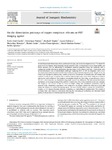Mostrar o rexistro simple do ítem
On the Dissociation Pathways of Copper Complexes Relevant as Pet Imaging Agents
| dc.contributor.author | Uzal-Varela, Rocío | |
| dc.contributor.author | Patinec, Véronique | |
| dc.contributor.author | Tripier, Raphaël | |
| dc.contributor.author | Valencia, Laura | |
| dc.contributor.author | Maneiro, Marcelino | |
| dc.contributor.author | Canle, Moisés | |
| dc.contributor.author | Platas-Iglesias, Carlos | |
| dc.contributor.author | Esteban-Gómez, David | |
| dc.contributor.author | Iglesias, Emilia | |
| dc.date.accessioned | 2022-10-19T16:58:48Z | |
| dc.date.available | 2022-10-19T16:58:48Z | |
| dc.date.issued | 2022 | |
| dc.identifier.citation | Rocío Uzal-Varela, Véronique Patinec, Raphaël Tripier, Laura Valencia, Marcelino Maneiro, Moisés Canle, Carlos Platas-Iglesias, David Esteban-Gómez, Emilia Iglesias (2022). On the dissociation pathways of copper complexes relevant as PET imaging agents. Journal of Inorganic Biochemistry, Volume 236, 2022, 111951. ISSN 0162-0134. https://doi.org/10.1016/j.jinorgbio.2022.111951. (https://www.sciencedirect.com/science/article/pii/S0162013422002409) | es_ES |
| dc.identifier.issn | 0162-0134 | |
| dc.identifier.uri | http://hdl.handle.net/2183/31841 | |
| dc.description.abstract | [Abstract] Several bifunctional chelators have been synthesized in the last years for the development of new 64Cu-based PET agents for in vivo imaging. When designing a metal-based PET probe, it is important to achieve high stability and kinetic inertness once the radioisotope is coordinated. Different competitive assays are commonly used to evaluate the possible dissociation mechanisms that may induce Cu(II) release in the body. Among them, acid-assisted dissociation tests or transchelation challenges employing EDTA or SOD are frequently used to evaluate both solution thermodynamics and the kinetic behavior of potential metal-based systems. Despite of this, the Cu(II)/Cu(I) bioreduction pathway that could be promoted by the presence of bioreductants still remains little explored. To fill this gap we present here a detailed spectroscopic study of the kinetic behavior of different macrocyclic Cu(II) complexes. The complexes investigated include the cross-bridge cyclam derivative [Cu(CB-TE1A)]+, whose structure was determined using single-crystal X-ray diffraction. The acid-assisted dissociation mechanism was investigated using HClO4 and HCl to analyse the effect of the counterion on the rate constants. The complexes were selected so that the effects of complex charge and coordination polyhedron could be assessed. Cyclic voltammetry experiments were conducted to investigate whether the reduction to Cu(I) falls within the window of common bioreducing agents. The most striking behavior concerns the [Cu(NO2Th)]2+ complex, a 1,4,7-triazacyclononane derivative containing two methylthiazolyl pendant arms. This complex is extremely inert with respect to dissociation following the acid-catalyzed mechanism, but dissociates rather quickly in the presence of a bioreductant like ascorbic acid. | es_ES |
| dc.description.sponsorship | The authors thank Ministerio de Ciencia e Innovación (PID2019-104626GB-I00) and Xunta de Galicia (ED431B 2020/52) for generous financial support. R.U.-V. thanks Xunta de Galicia (Grant ED481A-2018/314) for funding her PhD contract. V. P. and R. T. acknowledge the Ministère de l'Enseignement Supérieur et de la Recherche and the Centre National de la Recherche Scientifique. L.V. thanks CACTI (Universidade de Vigo) for X-ray measurements | es_ES |
| dc.description.sponsorship | Xunta de Galicia; ED431B 2020/52 | es_ES |
| dc.description.sponsorship | Xunta de Galicia; ED481A-2018/314 | es_ES |
| dc.language.iso | eng | es_ES |
| dc.publisher | Elsevier | es_ES |
| dc.relation | info:eu-repo/grantAgreement/AEI/Plan Estatal de Investigación Científica y Técnica y de Innovación 2017-2020/PID2019-104626GB-I00/ES/PLATAFORMAS INNOVADORAS PARA APLICACIONES RADIOFARMACEUTICAS/ | |
| dc.relation.uri | https://doi.org/10.1016/j.jinorgbio.2022.111951 | es_ES |
| dc.rights | Atribución-NoComercial-SinDerivadas 4.0 Internacional (CC BY-NC-ND 4.0) | es_ES |
| dc.rights.uri | https://creativecommons.org/licenses/by-nc-nd/4.0/ | * |
| dc.subject | Copper | es_ES |
| dc.subject | Positron emission tomography | es_ES |
| dc.subject | Dissociation kinetics | es_ES |
| dc.subject | Ascorbic acid | es_ES |
| dc.subject | Complexes | es_ES |
| dc.subject | Macrocycles | es_ES |
| dc.title | On the Dissociation Pathways of Copper Complexes Relevant as Pet Imaging Agents | es_ES |
| dc.type | info:eu-repo/semantics/article | es_ES |
| dc.rights.access | info:eu-repo/semantics/openAccess | es_ES |
| UDC.journalTitle | Journal of Inorganic Biochemistry | es_ES |
| UDC.volume | 236 | es_ES |
| UDC.startPage | 111951 | es_ES |
| dc.identifier.doi | 10.1016/j.jinorgbio.2022.111951 |
Ficheiros no ítem
Este ítem aparece na(s) seguinte(s) colección(s)
-
GI-REACT! - Artigos [110]






